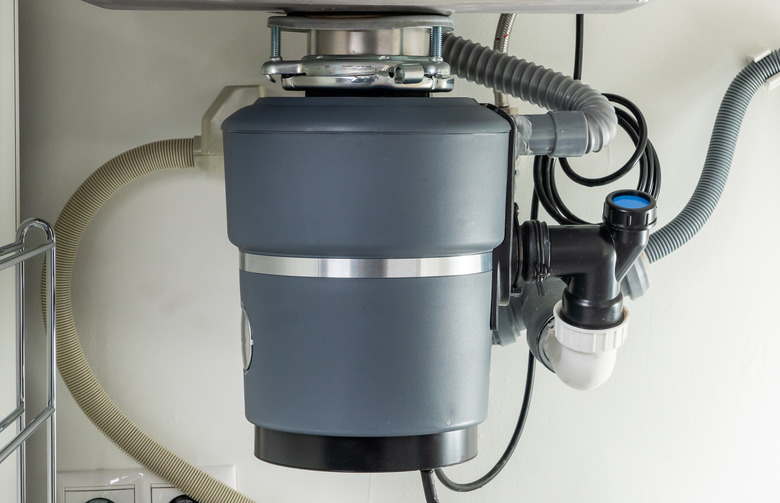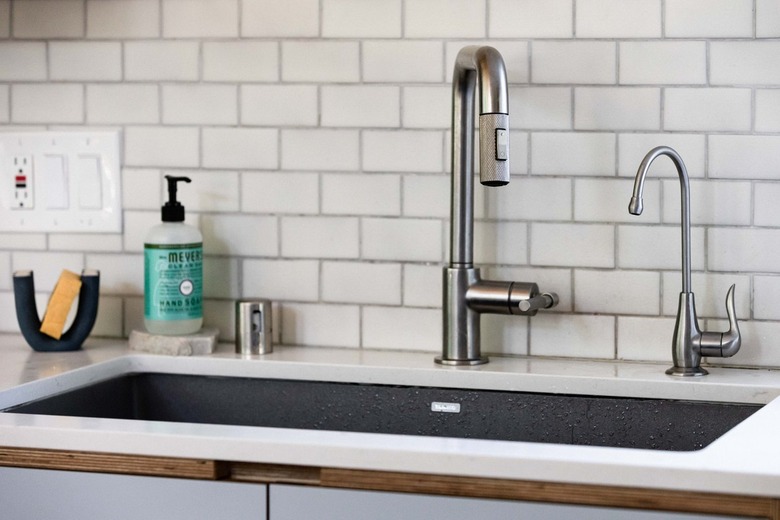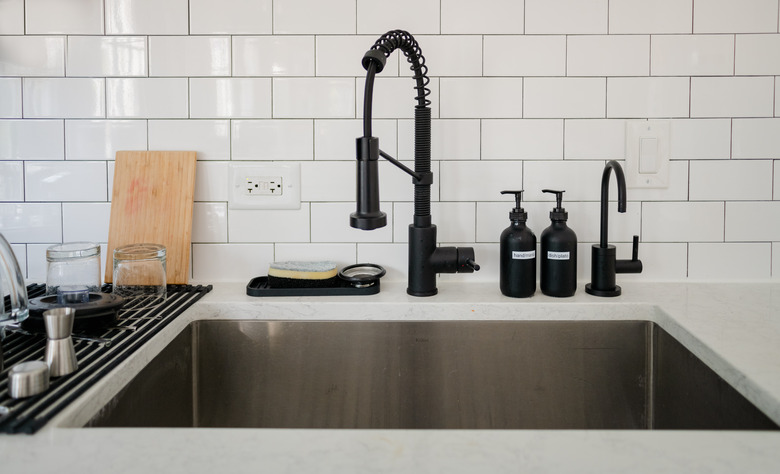What Is A Dishwasher Air Gap? Here's How It Works And How To Install It
We may receive a commission on purchases made from links.
Highlights
- A dishwasher air gap is the little metal or plastic dome that sits next to the kitchen faucet.
- Underneath the sink, the air gap connects to the dishwasher drain hose and the garbage disposal.
- Dishwasher air gaps prevent dirty drain water from backing up into the dishwasher.
- Most homeowners can tackle DIY dishwasher air gap installation, but a pro can help.
- Cleaning the air gap a few times a year will keep it in good working order.
Many American kitchens have a small stainless steel or chrome cylinder installed on one side of the kitchen faucet, and most people don't know anything about this kitchen sink fixture — other than the fact that it has something to do with the dishwasher. This small little piece is known as a dishwasher air gap, and it is critical in keeping the water in your dishwasher sanitary so your dishes come out clean.
What Is a Dishwasher Air Gap and Why Do You Need One?
What Is a Dishwasher Air Gap and Why Do You Need One?
A dishwasher air gap is a 2-inch-tall cylinder fitting located on either side of the kitchen sink, usually next to the faucet. The internal plumbing of the air gap prevents contaminated water from draining back into your dishwasher due to a stopped-up sink, a plugged tube or a clogged garbage disposal — otherwise known as "backflow."
As long as the air gap for your dishwasher works, there's no risk of backflow, meaning you'll never wash a load of dishes only to have them come out covered in old food scraps. In addition to preventing backflow, the air gap ensures that the potable water supply never interacts with your contaminated water.
If you want to prevent backflow in your dishwasher, you need a dishwasher air gap. While there are a few alternatives that can do this, the dishwasher air gap is the most effective, which is why so many plumbing codes require that every new dishwasher be installed with an air gap. An increasing number of cities and states add these codes every year, so homeowners are often surprised to find that the plumber they hired to install a new dishwasher won't install the appliance without first adding a kitchen air gap to the sink. Although it may be possible to bypass these codes by doing a DIY install, it's generally best to use an air gap because they are the only way you can eliminate the risk of backflow.
How Do Dishwasher Air Gaps Work?
How Do Dishwasher Air Gaps Work?
A dishwasher air gap has two hoses that have a gap of air between them to prevent cross contamination. One hose is a long drain hose extending from the dishwasher to the air gap, while the other runs from the air gap and down to the garbage disposal (or, if no garbage disposal is installed, directly into the tailpiece of the sink drain). Drain water is pumped from the dishwasher and flows through the dishwasher drain hose into the air gap. It then flows into the hose that goes to the garbage disposal or the tailpiece.
The fresh air in the air gap ensures that there is no way for negative pressure in the dishwasher drain hose to suction dirty water from a backed-up sink into the dishwasher. Instead, if the garbage disposal, sink drain or air gap drain line is plugged up, the water will flow out of the air gap and into the sink through the hole in the decorative head cover of the air gap.
Some air gaps actually have two inlets because they either connect a dishwasher with two drain lines (one for each compartment of the machine) or because they connect both a dishwasher drain line and a wastewater line from another appliance, such as a water softener or reverse osmosis water filtration system.
How to Install a Dishwasher Air Gap
How to Install a Dishwasher Air Gap
While many people hire a plumber to install a dishwasher air gap, it's a simple enough DIY project for most homeowners. While it's possible to install an air gap without a garbage disposal, it is always preferable to have a dishwasher drain into a garbage disposal when possible. That's because it sends larger pieces of debris into the garbage disposal where they can be ground up.
1. Find a Location for the Air Gap
The best place to install the air gap is next to the faucet. Many sinks have a predrilled hole in the sink deck precisely for this purpose. These are fitted with a flat, disclike cover if there is not already an air gap in place. If you have a hole like this already, you just need to remove the disc or existing air gap to install a new air gap. If you don't have a hole already, you'll have to use an electric drill and hole saw to cut a 1 3/8-inch hole.
If you have an undermount sink, which does not have a sink deck, then you have to drill the hole in the countertop. This is best done by a professional, especially for stone or quartz countertops.
2. Cut the Hoses to Length
- Have a helper hold the air gap body in position.
- Cut the drain line from the dishwasher, which is usually a 5/8-inch hose, to length.
- Cut a 7/8-inch hose to length, leaving a little slack in the line, to run from the air gap outlet to the garbage disposal or the fitting on the Y-branch sink drain tailpiece.
- Make sure the fitting can accommodate the hose size. Garbage disposals are sold with a 7/8-inch hose, but if you can't locate the hose, you will need to buy the larger hose and clamps from a home improvement or plumbing store.
3. Connect the Hoses to the Air Gap Body
- Use stainless steel hose clamps to connect the 5/8-inch dishwasher drain hose to the 5/8-inch inlet of the air gap.
- Connect a 7/8-inch hose to the 7/8-inch outlet of the air gap.
4. Install the Air Gap
- Push the air gap up through the hole on your sink or counter and then tighten it by threading the nut along the threads on the air gap.
- Put the metallic cover on the top of the air gap. Make sure the vents in the cap face the sink.
5. Connect the Hose to the Garbage Disposal or Tailpiece
- Check inside the drain nipple on the side of the garbage disposal to confirm that the plug has been removed.
- If not, punch out the plug with a screwdriver and then retrieve the plug by reaching through the sink opening of the disposal (be sure to shut off the power first).
- Push the 7/8-inch hose onto the disposal nipple and secure it with a hose clamp.
- If there is no garbage disposal, fit the hose onto the Y- fitting on the sink tailpiece and clamp it.
- Run the dishwasher on the rinse cycle to test the tubing for leaks.
How to Clean a Dishwasher Air Gap
How to Clean a Dishwasher Air Gap
A dishwasher's drainage system is a closed system. You can't see what is happening, so you may not know if there is a problem until it shows itself as a leak in the system or water pouring out of the vent in the air gap. Inspecting and cleaning the air gap system can help prevent problems later.
Food particles and grease that flow out of the dishwasher can clog the system. Clogs can also make the area around the air gap smell bad. Oftentimes, there is a slow buildup of gunk and grime in the drain hoses and at the garbage disposal connection or the drain tailpiece. Regular cleaning can keep the system working smoothly.
- Pull off the air gap cover and remove the inner diverter. It will either be a snap-on or screw-on component.
- Remove any debris and wipe away any buildup that is visible.
- Run an air-gap cleaning brush through the hoses. The open end of the hose you see is from the dishwasher drain; the space around it leads to the larger hose that goes to the garbage disposal.
- Clean the diverter and the inside of the air gap cover and then reinstall the diverter and cover.
Common Air Gap Problems (and How to Fix Them)
Common Air Gap Problems (and How to Fix Them)
Dishwasher air gaps are simple devices with no moving parts, but they can experience some problems:
Leaky Air Gap
Fix water leaks by either replacing the hoses or resecuring them.
Water Flowing Into the Sink from the Air Gap Vents
This is usually a sign that there is a blockage in the lines. For most blocks, you can remove the air gap cover and use an air gap cleaning brush to clear out any food particles or other things that could be clogging your drain hose.
Leaky Garbage Disposal Connection
If you only recently installed either a dishwasher or garbage disposal, it's possible that the installer forgot to remove the metal or plastic knockout plug in the garbage disposal. To fix this, simply remove the hose between the garbage disposal and air gap and then remove the plug with a screwdriver.
Air Gap Alternatives
Air Gap Alternatives
Although many experts consider a dishwasher air gap as the most effective way to prevent backflow, not all homes with dishwashers have air gaps. Some have what is known as the high loop, and some have a dishwasher standpipe installed.
High Loop
In a high loop, the dishwasher drain line loops up as high as possible in the cabinet under the sink. A bracket holds the line in place. From there it travels down to the garbage disposal or sink drain tailpiece.
The peak of high loops must be installed at least 32 inches above the kitchen floor in order to create enough of a slope to prevent dirty water from reentering your dishwasher. In theory, this should be high enough that if the drain pipe backs up, it should flow into the garbage disposal and/or the sink drain.
However, if pressure drastically drops on the dishwasher side of the line, this can cause a suction effect, and dirty water can get sucked back into the dishwasher. For this reason, air gaps are preferable, as they are the only way to guarantee that when the drain line becomes plugged, the contaminated water will flow into the sink rather than back into the dishwasher drainage line.
Standpipe
Installing a standpipe under the sink is another backflow prevention method. A standpipe is a vertical pipe that is 2 inches in diameter that feeds into a P-trap. They are more frequently used to drain clothes washing machines.
Placing a standpipe in the cabinet under the sink is a complicated plumbing installation to configure. The top of the standpipe has to be higher than the flood level of the sink, which is usually the rim, and the drain must be vented properly. Most experts consider them the least effective backflow prevention option.
Tip
If you're looking for an air gap alternative because you think they are unsightly, also consider hiding the air gap in plain sight. You can buy disguised air gap fixtures, like soap dispensers, that house the dishwasher air gap. This is a preferable alternative to using a high loop or standpipe method because it still guarantees that no wastewater will backflow into the dishwasher.






